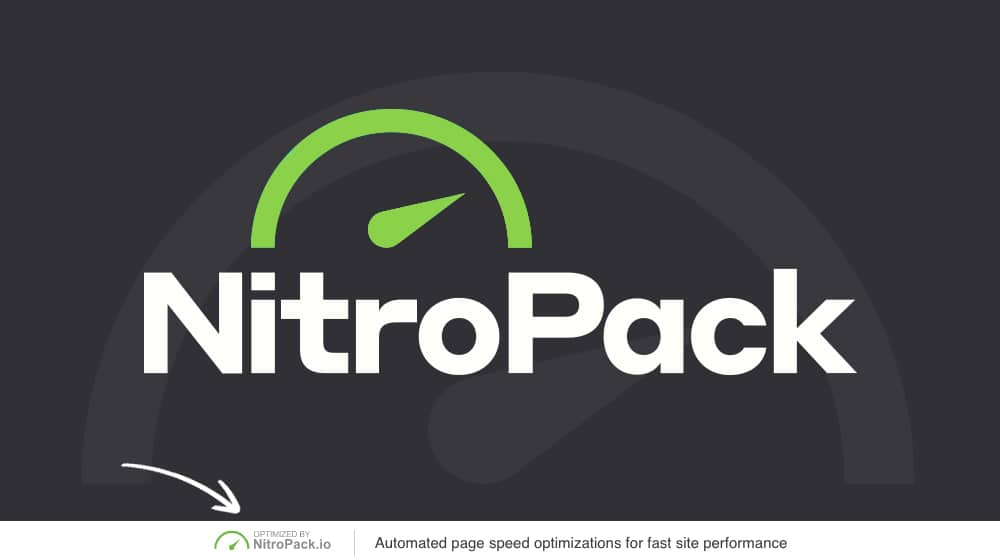Is It Possible to Remove the NitroPack Plugin Footer Link?

In the last few years, Google has been putting forth new SEO rules that have driven some webmasters up a wall, and have led others to develop an entirely new set of businesses. These are their new use of site speed, loading times, and other loading metrics as part of search engine ranking. Site speed, as measured by PageSpeed Insights, and the Core Web Vitals are both parts of an overall initiative to speed up the web by encouraging faster sites to rank better.
The new business model is, as you might imagine, tools and services designed to speed up your site. Talented developers have created suites of tools to help speed up slow sites, while others work with plugin developers to speed up their offerings or prevent them from slowing down a site.
What Is NitroPack?
As you might imagine from the intro, NitroPack is one such offering. NitroPack, found here, is a plugin that you can add to a website. They have options for WordPress, Magento, WooCommerce, and even custom-developed websites.

What all does it do?
- NitroPack includes a suite of caching tools, which allows dynamic websites to generate and serve static pages, has automatic cache expiration and refreshing, and has smart caching for different kinds of viewers.
- Image optimization. Their tools automatically smush images, compress them in lossless formats, size them more appropriately for a site, convert them to WebP, and lazy load them.
- Code minification. JS, CSS, and HTML can all be minified, to eke out those few extra kilobytes of saved space and help streamline code.
- CDN usage. Part of a fast site is serving content via a network of fast servers around the world, rather than routing all traffic regardless of location to one centralized server. NitroPack has a CDN service that they use to serve your content.
You can see their full list of features here. You can also read a longer defense of how their plugin works and why you should use it over custom development in this blog post.
It's no wonder that they're becoming increasingly popular as an easy way to speed up a site that otherwise would require a lot of individual plugins, custom development work, or tedious iterations to get sped up.
There's just one problem:
It's annoying, it stands out, it advertises a service you might not want to advertise, and it can disrupt your site design. It advertises to your competitors that you're optimizing your site speed, and they may decide to copy you and outperform you. It might even be a security concern; if someone finds a security hole in NitroPack, it would be trivially easy to find every site that uses it and auto-target them for exploitation.

There are plenty of reasons why people want to remove this advertisement, but can you? I've done some research, and I have a lot to say about the subject.
Option 1: Hiding the Link
The first option you have is to simply hide the footer link, or the footer itself, entirely. This is the simplest and easiest method, but it's also the most dangerous and least effective.
If you look up how to get rid of the link in your footer, you'll often see people suggesting a CSS trick. They recommend that you add an attribute to the footer link, namely this code:
.npf{display: none !important;}
Boom; next time you reload your site, the footer link is gone. Easy peasy, right?
Well, not exactly.
First of all, they updated their plugin so that this no longer works, but more on that later.
The second problem (and this is the biggest one here) is that you're not getting rid of the link. You're hiding it. If you were to load your site with CSS disabled, the link would still be there. If you were to inspect your site code, you could find the link there in your footer. It doesn't display to people running a standard browser, but people aren't who you're worried about.

Hiding a link is not the same as removing the link. It might look like it's gone, but Google, other search engines, and anyone who uses a bot/scraper to view the internet can just ignore that CSS directive. They look directly at site code, and can easily see hidden elements.
There's a very good reason for this: spam.
Years ago, when Google cared a lot about specific links and keyword usage but didn't have an advanced nuance for detecting PageRank sculpting or keyword spam, you would see websites use a lot of different tricks to hide text and links on their site. They might have a large white footer with white text that is full of spam keywords and links, effectively hiding it from users. They might have banks of keywords and links hidden with JavaScript. And, of course, they might hide all of this spam with the display:none; CSS code.

A site that ranks for keywords when those keywords aren't visible to the viewer's eye is a bad search result. Google very quickly started developing ways to detect this kind of spam, and penalized sites that hid text and links. You don't see it as much these days, simply because it no longer works.
What do you think Google is going to think when they load up your site and see that there's a hidden link in your footer that regular users can't see? That's right; they could get the wrong idea and think that you're a spam site. Not only that, but they might think that NitroPack is a spam site and that they're hacking other sites.
Matt Cutts, former head of Google's Web Spam team, kept it simple on his blog:
"I don't recommend that people use CSS to hide text."
The reason Google does this is that this spam practice was abused - a lot. It still happens, even today. If a hacker gains access to your site, they might destroy your site and steal your data. That's not very common, though, unless it's a personal attack on you or your business. More often, the hacker will be subtle and try to extract value from your site. They might add some hidden advertisements or hidden links to your site. Their money sites (the ones they link to) gain link value from your site right up until your site is penalized. Google often flags the sites that get linked to in this manner as potential spam sites.
I'm sure NitroPack doesn't want to fall into this category, which is part of why they make it so hard to remove their footer link. Hiding the link isn't going to do your website (or theirs) any favors. Your site will be using a spam technique to hide a link, and NitroPack could be affected because people who use their service are hiding those links. Chances are that NitroPack will blacklist you if they detect you doing this, and then you're left with a slow site and a non-functional plugin.
NitroPack also is aware that this is a method people use, and they've since made it much more difficult to do. They randomly generate the CSS classes for their footer and even the parent divs. They also use display:block !important; in their inline code, which will overrule any of your CSS changes to ensure that it stays visible.

The same is true for other footer-hiding features, like adding content over the top of it or setting margins to zero.
This is still technically possible with CSS or JavaScript. Even so, option one is not a good idea, even though it's the most commonly recommended option. Don't do this.
Option 2: Infinite Scroll
Option two is an option for some of you, and not for others, and it depends entirely on the reason you want to hide the link.
On the other hand, if you just don't want your users to see that you're linking to some third-party service, this might be an option. So what is the option?
Implement infinite scrolling on your site.

You might set this up on your homepage so that when users scroll down, more and more blog posts keep loading and they never reach your footer. It's kind of the same way Twitter and Facebook work with their feeds. Both of those sites have footers, but you never see them because your feed never ends.
You might also set it up on individual blog posts, so that when a user reaches the bottom of a blog post, they automatically transition to a related post, including changing the URL. You can do the same thing for a store, to transition through products.
There are three main drawbacks to this option.
1. The first is that it doesn't remove the link, or hide it. Anyone browsing with scripts turned off can still reach your footer, and still see the link, and Google can still see it because they don't render infinite scrolls. This can cause SEO issues of its own.
2. The second is that it requires a major revision of your website to do. Implementing infinite scrolling requires engineering scripts to trigger on your site, and may mean changing your site design, including stripping anything in your footer that you wanted to use and put it in a sidebar or top bar. It's a lot of major work to simply hide a plugin link.
3. The third issue is that it pretty much can't be used on every page of your site. An About Us page, a privacy policy page, a contact page; these don't have anything to infinite scroll to, and so the footer will appear. Any workaround is going to be janky at best. For those reasons, I don't recommend this option either.
Ultimately, this doesn't remove the link - it just prevents the user from ever seeing it without hiding it.
Option 3: Removing the Link
The third option is to hack the code of the plugin and remove the link.
I know I said that very simply, but it's not simple at all. NitroPack, for obvious reasons, doesn't want you to remove their advertising link from your site through unofficial means. They do have an official way to remove the link, which I'll discuss next.
The trouble here is that NitroPack is engineered to make it difficult to hide or remove the footer. There's no simple line of code you can comment out. You would need a developer to dig into the code and figure out how it works, figure out what scripts are generating the footer, and re-engineer the plugin to not have that code in it. Much of their code is hosted on their servers, so this may not even be possible.
That, my friends, is a lot of work. It's a lot of developer man-hours. That gets expensive very quickly. More importantly, even if it's possible, it's temporary. When you engineer a custom version of a plugin like this, it only works until the plugin needs updating. When you then update the plugin, the code has changed, and you need to re-engineer a footer-less version of the plugin again. Given how a lot of these kinds of plugins might update once a month or more, you're going to spend more time in the dev cycle than not.
I don't have an easy answer on how to do this. You'll have to pay a developer to handle it, and even then, you need to find one that is unscrupulous enough to want to violate terms of use and help you with this, while still having the talent to do it. You'll also most likely have to end up starting the whole process over again when they push a new update to their app.
Option 4: Buying a Paid Plan
The NitroPack link and logo in the footer are only present in the free version of the plugin. It's an alternative method of paying for the plugin - they get a free advertisement, and you don't have to pay anything. If you can't (or don't want to) pay for a paid version of the plugin, you "pay" by advertising the plugin on your site.

If you decide to opt for the paid version of the plugin, the footer disappears. It's that simple. You also get all of the benefits of a paid version of the plugin, including higher pageview limits, more CDN bandwidth, better and more sophisticated speed algorithms, more image optimization options, and priority support.
Sure, you do have to pay for it. The cheapest paid version is $17.50 per month if paid annually, or $21 per month if paid monthly. That's not an insignificant fee for a small site, but if you're making any sort of profit from your site, it may be worthwhile for you to use.
So, why not just pay for the plugin?
Option 5: Alternative Plugins
While paying for the plugin is the best option to still use NitroPack and get rid of the footer, there's one other way to get rid of the footer: don't use NitroPack.

NitroPack is a set of tools and configurations that speeds up your site. You can do that yourself. It's not as easy as setting up a single plugin, but you can use a variety of free plugins that don't have restrictions, or very cheap paid options, to get the same effects.
The drawback to this is that you have to wrangle multiple plugins and figure out how to get them all to work nicely together. The benefit is that you don't have to pay nearly as much (if anything), and you don't have to worry about third-party branding on your site.
Here are the major features of NitroPack, and what kind of plugins you can use to replicate the features for free or cheap.
- Site Caching: There are a handful of options including WP Rocket (my favorite), W3 Total Cache, WP Super Cache and others.
- Image Optimizations: I wrote a post a while back comparing several image optimization tools, including EWWW, Imagify, ShortPixel, and Smush. Imagify works with WP Rocket, so that's what I chose.
- CDN: I use KeyCDN, which is super easy to use and charges a trivial amount of money, under 5 cents per gigabyte used. Other CDNs include MaxCDN, Sucuri, Cloudflare, and Rackspace, among others.
- Code Optimization: Making your code smaller is very easy and typically can be done automatically, or manually with a tool any time you push an update. Try options like Autoptimize, Fast Velocity Minify, or Merge+Minify+Refresh. You can also look into lazy-loading your images and videos. All of these features are already packaged into WP Rocket, so if you chose that, you can skip this step.
- You can also check out my full list of WordPress plugins aimed at improving site speed and performance, to get an idea of other tools and techniques you can use.
So there you have it. With a simple selection of other plugins, you can replicate the features of NitroPack while avoiding the monthly cost and the obtrusive banner.
I think that NitroPack is a great plugin to get all of those features in one place, but the free plan that injects an advertisement at the bottom of your site is a deal-breaker. That said, paying for their cheapest plan is perfectly acceptable for a smaller site. The cheapest plan does cap you at 50,000 page views per month, however, and that's not exactly a lot of visitors. If your average visitor looks at 5 pages on your website, that amounts to only a few hundred unique visitors per day. If you get hit with some spam traffic, which is very common, you could end up paying a lot of money for those spam visitors.
If your site falls into the sweet spot of traffic where you can use the speed increases but it doesn't exceed the page views that they cap you at, NitroPack is great. On the other hand, if your site gets more traffic, you have the potential to go viral, or you don't have the budget for it, moving to some alternative plugins is going to be far more cost-effective.
Have you ever heard the expression "Good, cheap, or fast - pick two"? I think that's relevant here. For most, NitroPack is simply a quick "set-it-and-forget-it" solution. Displaying their advertisement on a business site is cheap, and paying for their service is not cheap compared to the alternatives.
The choice, of course, is yours.
2022 Update
Asif, the creator of the "Wordpress Geek" YouTube channel, shared some code that he wrote to remove the Nitropack footer. You can find it below in the comments section.
Also, I mentioned in this article that removing the footer link is against their terms of use, but I figured it would be worth re-iterating. To quote the Nitropack terms page:
"If Clients using the Free Plan are found to remove the promotional banner without subscribing the Client website to a Paid Plan, NitroPack shall consider this unfair usage of the service. In such a scenario, NitroPack preserves the right, at any time, to do a one-sided termination of the Service without prior notice."
So, while this may be legal to do, Nitropack is known to silently terminate the service of anyone who removes their footer link. You may find that your PageSpeed scores suddenly dropped without notice. Also, since NitroPack is constantly updating its platform, any code that is working now may stop working in the future.
In my opinion, these JavaScript and CSS hacks are temporary, and even if they are working, the risk of silently losing service and seeing your PageSpeed score drop makes it less appealing to me. If you like the software, I recommend you purchase it! Otherwise, do what I did and optimize your site the old-fashioned way.










May 24, 2021
I think NitroPack is a black hat tool. It fools Google into only reading inline CSS, JS, and HTML, and it ignores any additional file includes. This means the final score doesn't include parsing of your website's CSS or JS, so your website is never fully loaded. It's a matter of time until Google cracks down on this, they are cheating the system and selling that as a solution to their customers. Use their $250/year service at your own risk.
May 24, 2021
Hi Victor!
Wow, I had no idea. I read your post on your site (Webwhim), fascinating stuff. Thanks for letting us know.
June 09, 2021
James,
Do you think I should just remove Nitropack and go with a DIY method?
I'm getting good scores right now with Nitropack but the paid pricing doesn't make much sense and the badge is annoying me.
June 11, 2021
Hi Arafat,
The idea behind Nitropack is that you don't have to have any experience to achieve good performance.
A DIY method is undoubtedly a better option, but it also takes some fiddling to get it right.
Even today, we're still finding small optimizations that we're making to our site to pick up a point or two on Google PageSpeed.
Most people can achieve high 80's or even 90's with a DIY approach, but to get beyond that usually requires some form of coding knowledge to minimize layout shift, prevent image rendering, dequeue scripts from pages where they aren't needed, and so on.
If you have a curious mind and like tinkering, I think you should go with a DIY approach.
If you're not very tech-savvy and don't have time to bother with any of this, I would stick with NitroPack or another set-it-and-forget-it method.
January 07, 2022
You're a lifesaver! The footer link can really get annoying at times, so thanks for sharing these options.
January 12, 2022
Thanks Dominic! Which method did you use? Did you end up hiding it with CSS?
March 10, 2022
I wrote some code to remove the Nitropack code easily:
<script> document.addEventListener("DOMContentLoaded", function(){ let divc = document.querySelectorAll('div[style]'); for (let i = 0, len = divc.length; i < len; i++) { let actdisplay = window.getComputedStyle(divc[i], null).display; let actclear = window.getComputedStyle(divc[i], null).clear; if(actdisplay == 'block' && actclear == 'both') { divc[i].remove(); } } }); </script>March 10, 2022
Hey Asif!
Thanks for sharing this - impressive work!
I haven't tested this yet, but if any readers decide to give this a try, please report back and let me know if this worked for you.
Shoutout to your YouTube Channel "Wordpress Geek" - thanks again for the tip!
May 03, 2022
The CSS trick worked for me!
May 05, 2022
Thanks for letting me know!
August 08, 2022
It only appears to work until the page is cached but, they don't print their watermark until it is cached.
August 11, 2022
Thanks Adrian! I wouldn't be surprised if NitroPack fixed this. Good to know
July 20, 2022
Hi... is there a way to reset bandwidth and usage of the free plan..?
July 20, 2022
Hey John!
The 5000 pageviews and 1GB of bandwidth resets every month, so the best way to reset it is to wait until the next month.
In theory you could try creating a new account, but that might be violating their terms of service and it may not work, so I can't recommend it.
January 17, 2023
Just give your footer this CSS code:
{
margin-top:-35px;
z-index:50;
}
Because Nitropack banner is 35px.
January 23, 2023
Hey Salud,
Thanks for sharing! I don't see why this wouldn't work. Love a good pure CSS fix 🙂
August 10, 2023
Shouldn't it be margin-bottom? Or am I missing something
August 16, 2023
I believe you're right 🙂 he had a small typo there.
With a negative value, margin-top:-35px would move it up 35px when we want to move it down (off the screen) 35px.
There are a bunch of ways to do this, I'm sure; position:relative with left:-9999px, height:0px with overflow:hidden and margin/padding 0px, and so on.
July 10, 2024
Thanks a lot!
This solution works like a charm.
Please note, that if your element does not have position: relative / position: absolute, z-index will do nothing.
In my case it worked without the z-index anyway.
Usually NitroPack will add it to the very end anyway.
P.s. If someone of the People from NitroPack reads this:
I like the plugin and I would pay for it, but it is way to expensive! Also, there is no attractive option for agencies as it seems.
July 16, 2024
Hey Daniel! Thanks for sharing.
I don't use Nitropack, and of course I don't support breaking their terms of service, but I get asked this one every now and again by our clients. Their business model is to include a big logo at the bottom of your site, so I suppose the first thing people are going to try to do is to remove it, right? What can they expect.
The free account still has limits in place, so I suppose you'll still run into issues once you exceed the pageviews on the free plan.